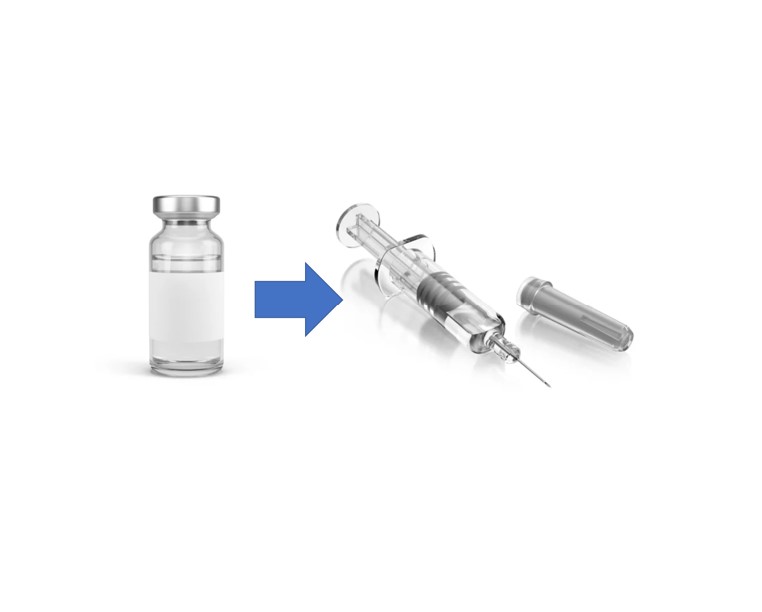Key considerations when transitioning from a vial to a pre-filled syringe or a cartridge in an auto-injector device
By Jo Anne Jacobs

About the Author
Jo Anne has 30 years’ experience in the development, scale-up, clinical and commercial manufacturing of pharmaceutical/biopharmaceutical injectable products
She has held various leadership roles at AAi Pharma (now Alcami), the Pharmaceutical Development Center (Medical University of South Carolina), Cook Pharmica, Catalent, and INCOG BioPharma Services.
Introduction
The growth in the number and types of biologic therapeutics has led to increased interest in self-administration of these products. Prefilled syringes, autoinjectors, pens, and wearable pumps are becoming more prevalent. Migrating an existing product from a vial presentation to a syringe or cartridge presentation offers several advantages. These include ease of administration, improved safety, and reduced risk of contamination. Long term, they may also lead to cost savings. The overall cost of the syringe configuration may be higher, but the decrease in waste and increase in patient compliance can offset this cost.
How does the formulation team approach the transition?
To mitigate potential regulatory roadblocks, making no changes to the drug substance final formulation is the most straightforward route. Since you are starting with a product currently in clinical trials or commercialized, the first steps will be gathering the known information:
- Target product profile (TPP),
- Product critical quality attributes (CQA),
- Existing risk assessments, and
- Drug product development report.
After gathering the baseline information, a cross functional team (i.e., formulation, manufacturing, quality control, and quality assurance personnel) should develop a gap assessment comparing the vial presentation data and the proposed attributes of the new final product presentation. From here, the team will perform a risk assessment to evaluate the gaps and propose a development plan for the new syringe presentation.
The development and manufacturing teams should consider these critical items:
- What’s the route of administration? Currently, the product is given by intravenous (IV) infusion, but the end goal is to develop a dosage suitable for subcutaneous administration.
- Are the current formulation constituents appropriate for subcutaneous injection? For example, citrate buffers are known to cause pain at the injection site.
- Are the protein concentration and the injection volume appropriate for subcutaneous injection? The protein concentration may not be high enough to achieve the effective therapeutic dose in a small injection volume, leading to a more complex path for the new product. For example, if a higher protein concentration is required, the formulation process could require the addition of tangential flow filtration (TFF) and additional formulation stabilizers, such as amino acids, sugars, and surfactants. Highly concentrated proteins tend to have higher viscosity and are more prone to aggregation. This further complicates the process and reinforces the desire to use the current formulation as is.
Next, what compatibility testing is needed?
Results from the gap assessment will indicate how much additional formulation work may be required. The biggest known gap is the difference between the product contact materials of the vial/stopper presentation and those of the syringe/plunger configuration. Assuming that a complete study of the compatibility and extractable/leachable picture of the current primary components was done during the original formulation work, picking a syringe and plunger of the same materials and stopper coating is the obvious choice. One outstanding question is the impact of the silicone coating of the interior syringe barrel and potential residual tungsten from the syringe manufacturing process on the protein characteristics. A necessary first step will always be performing a comparative stability study of the formulation in both configurations.
Lastly, what stresses will the bulk product undergo during formulation, filtration, and filling into the cartridge or syringe?
Again, the gap analysis will help here. However, performing actual processes with appropriately scaled down models in the formulation laboratory helps gather data needed for the next steps. These findings affirm that the proposed manufacturing scale, equipment, and processes will have a high probability of success. The formulation laboratory testing can also highlight potential areas of concern that may need to be mitigated prior to proceeding to demonstration batches.
A well-designed and conducted experimental design at this phase can yield high quality information while minimizing the amount of material needed, time required, and costs incurred, to prepare for cGMP manufacturing.
Drugs currently in clinical trials or commercially available should have characterization and robustness data available for the current process. If the same or equivalent processes and equipment are used for the new presentation, a thorough process risk assessment (e.g., PFMEA), versus generating all new data, should suffice.
The major players that impact a drug’s transfer center on mixing time and speed, filtration process (e.g., bioburden reduction followed by redundant sterile filtration), and filling mechanism (e.g., peristaltic pump versus time-pressure filling). Here are other topics to consider:
- Scale – Is the proposed manufacturing scale significantly larger than what has been produced before? This can impact the bulk drug substance thawing time, mixing time (and mixing speed), filtration time, and total filter contact time.
- Storage conditions – If the final product is refrigerated or frozen, how much time at room temperature will be required for batch processing? The considerations here must include the total amount of time required not only for formulation, filtration, and filling, but for time required for 100% visual inspection, assembly into a safety device or autoinjector, and final packaging. Planning for potential delays, at any point in the process stream, should also be considered. Have robust risk management plans in place to maintain product quality and mitigate product loss every step of the way.
It is imperative that the team carrying out the project of transitioning a product from vial to a syringe or cartridge has the necessary knowledge, experience, and equipment to get the job done. This includes not only their technical expertise, but also their procurement and material handling services, their analytical and microbiological testing competence, and of course, an overarching, transparent Quality System that ensures consistent, compliant, and safe products are delivered to patients.
